Fight Club Blu-ray Movie
HomeFight Club Blu-ray Movie 
10th Anniversary Edition20th Century Fox | 1999 | 139 min | Rated R | Nov 17, 2009
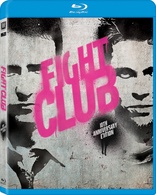
Movie rating
8.6 | / 10 |
Blu-ray rating
| Users | 4.7 | |
| Reviewer | 4.5 | |
| Overall | 4.6 |
Overview
Fight Club (1999)
An insomniac office worker and a devil-may-care soapmaker form an underground fight club that evolves into something much, much more.
Starring: Brad Pitt, Edward Norton, Helena Bonham Carter, Meat Loaf, Jared LetoNarrator: Edward Norton
Director: David Fincher
| Crime | Uncertain |
| Thriller | Uncertain |
| Dark humor | Uncertain |
| Drama | Uncertain |
| Psychological thriller | Uncertain |
| Mystery | Uncertain |
| Action | Uncertain |
| Surreal | Uncertain |
Specifications
Video
Video codec: MPEG-4 AVC
Video resolution: 1080p
Aspect ratio: 2.40:1
Original aspect ratio: 2.39:1
Audio
English: DTS-HD Master Audio 5.1 (48kHz, 24-bit)
French: DTS 5.1 (48kHz, 24-bit)
Portuguese: Dolby Digital 5.1
Spanish: Dolby Digital 5.1 (448 kbps)
English: Dolby Digital 2.0 (224 kbps)
Subtitles
English SDH, French, Portuguese, Spanish, Cantonese, Danish, Dutch, Finnish, Mandarin (Traditional), Norwegian, Swedish
Discs
50GB Blu-ray Disc
Single disc (1 BD)
Packaging
Slipcover in original pressing
Playback
Region free
Review
Rating summary
| Movie | 4.0 | |
| Video | 4.5 | |
| Audio | 5.0 | |
| Extras | 4.0 | |
| Overall | 4.5 |
Fight Club Blu-ray Movie Review
"When the fight was over, nothing was solved, but nothing mattered."
Reviewed by Casey Broadwater November 16, 2009In the decade that’s elapsed since Fight Club first pummeled audiences and divided critics, many of the film’s themes have remained remarkably pertinent. Despite a massive recession, consumer culture is still the driving force of the economy. We’re still, as übermensch anti-hero Tyler Durden would put it, “the bi-products of a lifestyle obsession.” Cognitively preprogrammed for brand awareness and mass acceptance of corporate advertising, we are our iPods, our hybrid cars, our trendy neighborhoods and 500 channels of high definition television. The rise and dispersion of so- called metro-sexuality has challenged and redefined traditional notions of masculinity. And, of course, the almost unfathomable events of September 11, 2001 have eerily echoed the film’s explosive dénouement. As much as Fight Club is a cultural touchstone of late-1990s, pre- Y2K America, it’s still as relevant as the morning paper, as potent as bull shark testosterone.
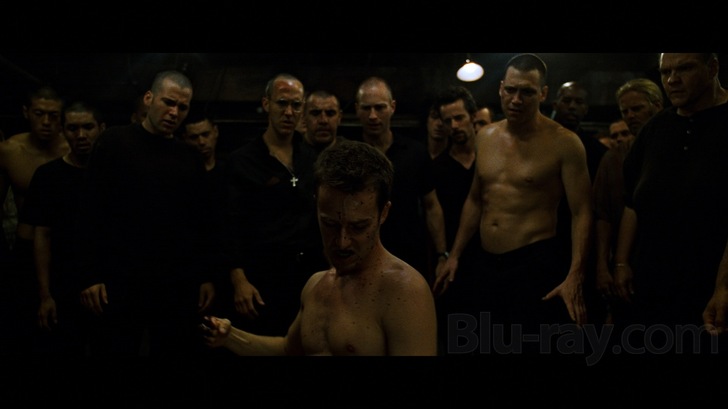
This is Fight Club.
The films needs little introduction, but for those who might’ve spent the past ten years in a cave or holed up in some mountaintop monastery, I’ll lay out the fundamentals. Based on a novel by shock-scribe Chuck Palahniuk (Choke) and directed by David Fincher (Zodiac, The Curious Case of Benjamin Button), Fight Club is an existential thriller that examines the emasculated place of men—not mankind, but men—on the eve of the 21st century. When the film opens, our unnamed narrator—who occasionally refers to himself as Jack (Edward Norton)—has his mouth wrapped around the barrel of a pistol, the first of the film’s many sexually suggestive symbols. At the other end of the gun is Tyler Durden (Brad Pitt), a man who has abandoned material pursuits and found himself enlightened by violence.
We flash back to the beginning. Jack—a stand-in name for our heroic Everyman—is a corporate numbers drone, a risk management assessor for a major automobile manufacturer. His life is defined by his Ikea-furnished lifestyle solutions, by his khakis, his dinner plates, by the monotony of his insomniac’s existence. To combat his sleeplessness, he begins attending random support groups—for everything from testicular cancer to sickle cell anemia— where he meets Marla (Helena Bonham Carter), a “faker” who lives like she might die any moment. (“The tragedy, she says, is that she didn’t.”) After a massive explosion mysteriously destroys his condo, Jack moves in with Tyler Durden, the unfettered id to Jack’s cautious super- ego. Tyler makes soap from liposuction fat—he “sells women their own fat asses”—and regularly expresses variations of the credo that “it’s only after we’ve lost everything that we’re free to do anything.” Together, the two start the titular fight club, a place where men can go to strip themselves of societal expectations and, for a few bloody moments in the ring, experience true glory and self-worth. In time, Tyler recruits members of the club to be part of “Project Mayhem,” a terrorist cell-cum-practical joke squad rooted in a kind of anarcho-fascist-nihilism. Obviously, this escalates way out of hand, and Jack has to confront both Tyler and his own fractured and conflicted thoughts about everything that’s happening.
Early reviews of the film were polarized. Some critics championed Fight Club’s breakneck visual acumen and dark-as-a-black-eye comedy. Others saw nothing funny in a post-MTV mishmash of styles that seemingly glorifies violence. Some praised the sharp-tongued verbal acuity of its script and the braveness of the film’s no-holds-barred nihilism. And still others disparaged Tyler Durden’s empty philosophizing as juvenile, a pop-neo-facism for violence-prone teens too immature to realize that, despite all the cool posturing and profound-sounding quips, Durden’s solutions to the problems of modern masculinity are far more troubling than the problems themselves. Pro and con, all of these arguments hold up today, as the film has been blindly admired, dismissively vilified, and frequently misunderstood for a decade now. Take frat- boys, for example. Fight Club posters are—or were, when I was in college—almost as ubiquitous in dorm halls as spent beer bottles. One wonders…are the macho, fist-pumping, high- fiving hangers of these posters—who are, in essence, partly defining their identities through a professed admiration of Fight Club—aware, at all, of the film’s latent homoeroticism? It’s an apparent contradiction that I imagine provocateur Sasha Baron Cohen might have explored in some parallel-universe version of Brüno.
Whether you think Fight Club is the most stylish thriller of the 1990s or just a husk of pseudo-philosophy wrapped around an empty core—I’m somewhere in the middle—the film is undeniably well-produced. David Fincher evolves his visual style from The Game and Seven to form a gritty, industrial aesthetic, with stripped down colors and deconstructed set design. The cinematography is stylized and evocative, the camera movements assured and occasionally glitzy, but always in service of the film’s wink-wink ironic detachment, and never to simply draw attention to itself. But the real highlight here is the acting. Edward Norton is alternately frazzled and incredulous; when he finally strips off his Oxford button-down and gets into the ring, he’s like a man reborn. When he returns to work the next day, thoroughly disheveled, it’s as if what was once a stuffed shirt, going through a humdrum routine, has been replaced by a walking smirk, a badass with unhindered self-confidence. Brad Pitt is simply unpredictable—you never know what he’ll do next—and he handles his often viciously sarcastic dialogue with effortless cool. And Helena Bonham Carter, who can imagine her in a Merchant Ivory film after seeing Fight Club? Her Marla is the personification of wanton, uninhibited sex and belligerent neurosis. The script is tightly written, the editing is brisk and playful, and the action is brutal.
Is the violence condemned or condoned? Is it gratuitous or essential to the film’s polemic? Ultimately, if Tyler Durden is the out-of-control id and Jack’s former life represents the restraint of the socially conscious super-ego, then I think that we, the audience, must serve as the ego, finding the compromise between the dichotomies and arriving—ourselves—at whatever balance can be obtained between the emasculation of materialism and the skull-crushing, bone-breaking self-annihilation presented in Fight Club.
Fight Club Blu-ray Movie, Video Quality 
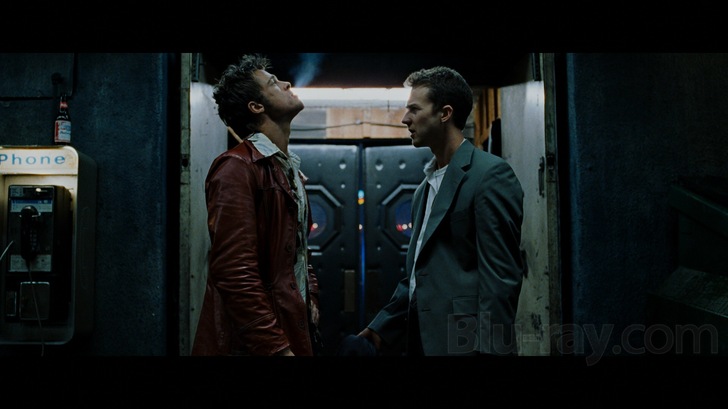
Fight Club has always had a distinct visual style, a dirty, bruised and beaten aesthetic, at once slick as wet blood and coarse as sandpaper. Those that like their high definition movies bright and clean—with artificial sharpening and all traces of grain digitally scrubbed to oblivion— won't know what to make of this release, with its dingy color scheme and obviously filmic look. But fans who like to see a director's intentions honored will be knocked silly by this fantastic 1080p/AVC-encoded transfer, which proves to be an appreciable upgrade from prior DVD releases, especially when it comes to overall clarity and color depth. There are still a few soft shots—see Marla's confrontation with Jack at the cancer support group—but taken as a whole, Fight Club is sharp and defined. Close-ups display fine facial textures—particularly brutal when you're looking at Jared Leto's pulverized face—and longer shots are nicely resolved, allowing heretofore unseen detail. While truly bright, vivid colors are in the minority here—there are exceptions like Marla's blue shirt—the desaturated palette is filled with the greenish pallor of fluorescent lights, bronzed skin tones, and grimy, industrial grays. The colors, even if they're not "eye-popping," seem more weighty and intense this time around. Likewise, black levels are dense and deep, prompting a bit of intentional crush here and there, but generally giving the image a satisfying sense of presence. Contrast, as always, is slightly heightened and, at times, purposefully lurid. And grain is apparent throughout, in varying levels, giving the film an appropriately gritty patina. Aside from some minor contrast wavering in two or three scenes, I didn't detect any overt issues—no banding, blocking, haloing, jaggies, or artifacts. Whether or not the visual upgrade here warrants repurchasing the film on Blu-ray will depend on your own tastes and budget, but this is certainly the best Fight Club has ever and perhaps will ever look on home video.
Fight Club Blu-ray Movie, Audio Quality 

Rounding out the A/V package is an absolutely pulverizing DTS-HD Master Audio 5.1 surround track that will kick your home theater's ass and take its name. There are several demo-worthy showpieces here. Listen as Jack imagines a violent mid-air collision between two planes; steel rips through steel, sending shrapnel flying through the speakers with pin-point precision as wind whips terrifyingly through the rear channels. Or replay the scene when Tyler lets go of the steering wheel and allows the car to crash; metal twists and tears wrenchingly, screeching and grating from front to back as the car barrels towards the audience. And yet, these big audio moments are just the cherries on a sonic sundae. The sound design throughout the film is consistently engaging and immersive, delivering ear-shattering blows when called for and bringing quieter scenes to life with subtle, place-establishing ambience. Take, for instance, one of the cancer support group scenes. Pick out all the individual sounds. You'll hear the speaker drone through a microphone, her voice reverberating appropriately. You'll hear the members shift and shuffle quietly in their pews. Somewhere, in a distant room, children are running and playing. Outside, an ambulance passes by, the Doppler effect of its siren a grim portent. And this is just one example; nearly every scene is built upon a lively and convincing soundfield. While Edward Norton's voiceovers seem a bit quiet at times, dialogue is easily understood and reflects the acoustic qualities of the surroundings. Finally, if the big audio moments are the cherries on this sundae, the electronic score by The Dust Brothers is the chocolate sauce. The trip-hop spookiness and big beats sound a bit dated now, but the music is still bold and effective. I really can't drum up any complaints about this track; it's loud, aggressive, full-bodied, and thoroughly impressive.
Fight Club Blu-ray Movie, Special Features and Extras 
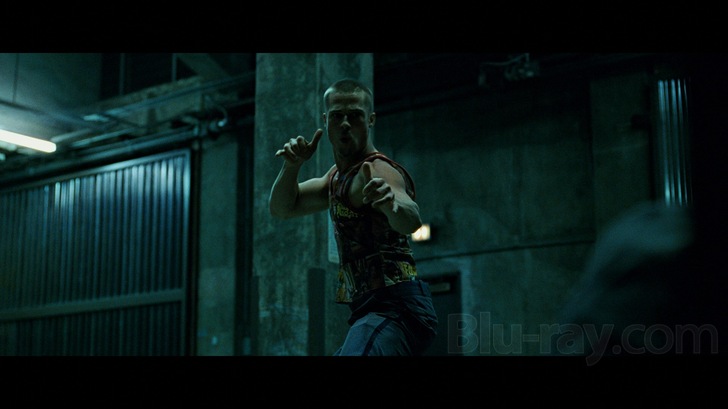
The bulk of the bonus features here are identical to those on the 2-disc special edition DVD, but
there are few additions to sweeten the deal, including an interactive audio featurette, an
acceptance speech at Spike TV's 2009 Guys Choice Awards, and a searchable index of
commentary topics and in-movie references.
Commentary Tracks
How many films arrive with four commentaries on a single disc? As owners of the 2-disc special
edition DVD know, these tracks are a veritable treasure trove of arcane Fight Club
knowledge, from making-of production details and on-set anecdotes to character analysis, script
dissection, and directorial decision-making. David Fincher provides an excellent stand-alone track,
and he's joined in the second commentary by Brad Pitt, Edward Norton, and Helena Bonham
Carter for even more lively discussion. Author Chuck Palahniuk and screenwriter Jim Uhls provide
the perspectives of the film's progenitors for the third track, and the fourth is a collaborative
effort from DP Jeff Cronenweth, Costume Designer Michael Kaplan, Production Designer Alex
McDowell, Visual Effects Supervisor Kevin Haug, and Visual Effects Editor Doc Bailey. All of the
tracks are worth listening to, but the sheer amount of content can be overwhelming. Which leads
us to:
Insomniac Mode: I am Jack's Search Index
Essentially, this mode has two functions. First up is a "topic search," which allows you to scroll
through an index of people, places, and things referenced in both the movie and in the special
features, from "Abraham Lincoln" to "Zach Grenier." Selecting one of these topics will take you to
either the point in the film where it's referenced, or to the appropriate featurette in the special
features. It's a neat inclusion, but I can't see myself using it, as I'm more likely to simply plow
through the bonus features one after another. More useful, though, is the "commentary guide,"
which, when activated during the film, engages a pop-up menu that allows you to see, in "real
time," what topics are being discussed in each of the four commentary tracks. This lets you
switch at will between the commentaries and listen only to topics that interest you.
A Hit in the Ear: Ren Klyce and the Sound Design of Fight Club (1080p)
Sound designer Ren Klyce explains, in a brief intro to this interactive feature, how sound can
"define a film's dramatic and psychological landscape." After viewing the introduction, you can
select one of four scenes and remix the audio yourself, manipulating both the realistic and
expressionistic audio elements that make up each scene. Basically, you can change the overall
volume coming from each speaker of a 5.1 setup, as well as adjust the balance between the
"real" sound effects and the more impressionist flourishes of sound design. It's not incredibly
intuitive, but audiophiles may have fun tooling around here for a few minutes. It's self-
explanatory, but you do need a 5.1 speaker arrangement to make full use of this
feature.
Flogging Fight Club (1080i, 9:58)
Here, Mel Gibson rides in on a horse—wearing a Viking helmet—to bestow the Guy Movie Hall of
Fame honor to Fight Club at Spike TV's 2009 Guys Choice Awards. We also get to see
David Fincher, Brad Pitt, and Edward Norton prepping for their acceptance speech, which largely
consists of bashing the critics who initially bashed the film.
Behind the Scenes Vignettes (SD)
The 16 or so behind-the-scenes clips here are divided into three sections: Production, Visual
Effects, and On Location. With the exception of On Location, which is a stand-alone look at some
of the film's props and choreography, the rest of the clips are somewhat cumbersomely arranged.
First, you have to select a segment to view, and then select an angle and an audio track. You can
also change the angles and audio tracks—there are one to three, tops, per clip—by pressing the
respective buttons on your remote. To be honest, I would prefer one big, long production
documentary.
Deleted and Alternate Scenes (SD, approx. 16 min.)
There are seven severed or altered scenes, most of which were cut for pacing or trimmed of
objectionable material.
Publicity Material (SD, approx. 30 min.)
Includes three trailers, 17 TV spots, 5 internet spots, 2 hilarious public service announcements, a
music video, and the transcript of an interview with Edward Norton. There are also three self-
playing galleries here, one each for lobby cards, press kit materials, and stills.
Art Gallery (1080p, approx. 30 min.)
Here you'll find high definition, self-playing galleries of visual effects stills, photos of the Paper
Street house, costumes and makeup, pre-production paintings, the "brain ride" map, and all of
the storyboards for the film.
Fight Club Blu-ray Movie, Overall Score and Recommendation 
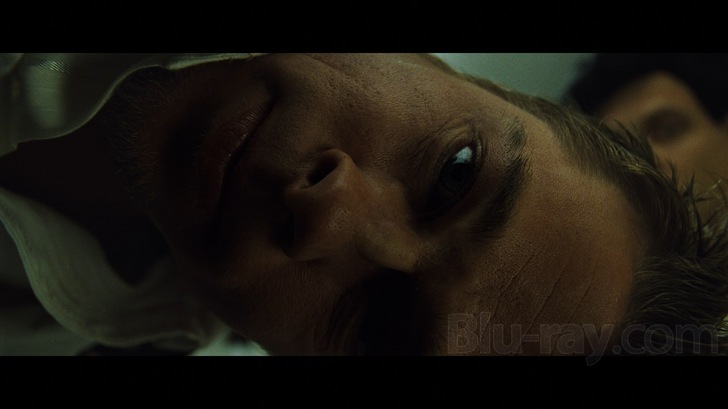
The question always arises, in cases like this, of whether it's worth it to upgrade from the DVD release of a catalog title. In the case of Fight Club, I'd say yes, with few reservations. There's not much in the way of new supplementary material, but with a visual boost in clarity and a sonic pummeling—courtesy of a lossless audio track—this Blu-ray release of Fight Club is a heavy hitter, and a must-have for fans. Highly recommended.
Other editions
Fight Club: Other Editions

Fight Club
10th Anniversary Edition
1999

Fight Club
10th Anniversary Edition
1999

Fight Club
San Diego Comic-Con 2013 Limited Edition
1999

Fight Club
Special Edition | Fox Icons
1999

Fight Club
10th Anniversary Edition
1999

Fight Club
2014 Comic Con Exclusive / Limited 500 Copies
1999

Fight Club
1999

Fight Club
10th Anniversary Edition | Deadpool Photobomb Series | Deadpool 2 Movie Cash
1999

Fight Club
Comic Con Exclusive
1999

Fight Club
10th Anniversary Edition | Deadpool Photobomb Series
1999

Fight Club
1999
Similar titles
Similar titles you might also like

Revolver
2005

Memento
2000

Se7en 4K
Seven 4K
1995

Insomnia
2002

The Departed 4K
2006

The Way of the Gun
2000

Pulp Fiction 4K
1994

The Girl with the Dragon Tattoo
2011

The International
2009

A Clockwork Orange 4K
1971

A History of Violence 4K
International Cut
2005

Magnum Force
The Dirty Harry Collection
1973

Four Brothers
2005

Gone Girl
2014

Prison Break: The Final Break
2009

Get the Gringo
2012

The Boondock Saints
20th Anniversary Edition
2000

Basic
2003

Reservoir Dogs 4K
30th Anniversary Edition
1992

Lord of War 4K
2005